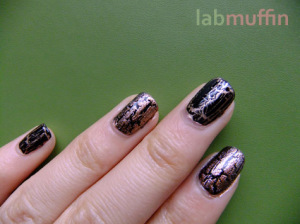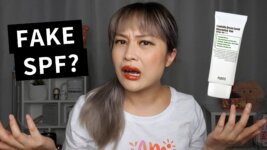There are a few common sciencey questions I get asked a lot, and for some of them, I have a strong suspicion on how they work, but I can’t confirm it properly (without misappropriating university resources, anyway). So here’s a post where I speculate about how things work, which may or may not turn into a series of posts…
How does shatter/crackle polish work?
 |
| Old school! |
As a sciencey nail blogger, this is the question I get asked the most! I’ve seen a lot of posts saying that ethanol (or ethyl alcohol, or alcohol SD40) is the ingredient that makes it shatter, but that’s not the full story. I know this for a fact, because I’ve tried adding various amounts of ethanol to various types of nail polish and none of them wanted to even separate. More importantly, I’m sure many, many other people have played with it too, but no one’s written about their successful crackle franken, even though crackle came out over 2 years ago. Additionally, most people who try to explain shatter claim that it’s because ethanol evaporates faster than usual, but ethyl acetate, the most common nail polish ingredient, has a lower boiling point and evaporates faster.1
Ethanol is definitely a big part of why shatter does what it does – it doesn’t stay well mixed with the other nail polish ingredients and helps it go uneven, plus it could be part of why shatter won’t shatter on bare nails2. it’s also about the other ingredients in the polish.
This area isn’t my forte, but I think polish companies have taken care to formulate a polish which sticks together quickly, is very brittle, and doesn’t adhere well. In shatter/crackle ingredients lists, you’ll notice “adipic acid/neopentyl glycol/trimellitic anhydride” quite high up while “nitrocellulose” is low, whereas in most normal polishes, it’s the other way around (most polishes don’t have adipic acid/neopentyl glycol/trimellitic anhydride at all). This different formulation is probably also why shatter tends to flake off so easily and dry dull.
How does spotted/bubbly polish work?
The key ingredients in OPI’s Black Spotted that aren’t in regular polish are heptane, which is a very hydrophobic (water-hating) solvent, and plain old water. Polish is quite hydrophobic to begin with, so when it’s mixed with heptane it’s even worse at mixing with water. When the mixture of water-hating polish and little droplets of water hits the nail, the droplets expand and form little holes through which you can see the polish underneath.
The heptane in the polish is also why all the spotted-style polishes were “exclusive” to non-US countries – it’s not a very nice thing to have in cosmetics and understandably there are laws against it in some countries, although the tiny amounts in a nail polish are very unlikely to harm you.
I’ve tried frankening a spotted polish out of commonly found household ingredients, but so far I’ve failed. Of course, there’s the water marbling method of getting a similar effect without all the mixing hoo-hah, where you float polish and spray it with hand sanitiser to create little dots in the polish – this will also work with other alcohol-based sprays, like perfume and hairspray.
Why does Revlon polish end up looking dusty when I swatch them on sticks, but not on my nails?
A few of my Aussie Nails ladies have noticed this happening. The only explanation I can think of is that Revlon polishes typically contain an unusual ingredient, tribenzoin (it’s also in some Sephora polishes). It’s usually a moisturising ingredient, but I’m not sure what its function is in the nail polish. I’m guessing that on your mani, it’s able to sink into your porous nail, but since plastic is less penetrable, the moisturiser has nowhere else to go but up to the surface, where it looks like “dust”.
1. It’s possible that ethyl acetate evaporates slower because it’s more attracted to the other ingredients in nail polish than ethanol (ethyl acetate is non-polar, and most things in polish are also non-polar, and like attracts like in chemistry).
2. Nails and ethanol are attracted to each other (both are polar), so ethanol probably absorbs through the nail plate too quickly for the shatter to work. Additionally, nail polish is non-polar, so ethanol probably slides across it quite easily, helping the shatter polish shrink across the nail and create larger gaps, but this probably also has to do with how smooth and shiny the polish is compared to the bare nail.






I liked this post a lot! I hope it does become a series. I always like your take on things. 🙂
Thank you muchly! 🙂
This is great, and makes a lot of sense! Whenever I think about the science of polish I kind of boggle, there’s a lot of ingredients and thought going into things that equate to pretty colours on our nails, for most of us. Thank you for the information!
I’m glad you liked it. I am an organic chemist by training, so every time I pick something up, I automatically start thinking about all the ingredients and what they’re doing there – it’s like a reflex now!
this is a really interesting post, and its true that i have never seen a crackle franken!
This is really cool! I’m always asking my dad or husband, what do you think makes it do that? Of course, they’re not scientists, but it’s fun to guess!
Wow some really interesting info here! Thanks for sharing!
xx
Very timely as I just bought a bottle of crackle today and a bottle of Opi spotted the other week.
Thank you.
As a science nerd myself, this post made me swoon with happiness! I hope this turns into a series!!
Hopefully soon 🙂
cool post, nice to have inside view of your lab brain 😉
The nerd in me loves this post. Thanks for the info!
Great post. It would be nice to have a series of similar posts. So do you think a crackle polish could be changed into a regular (non-crackle) polish?
The easiest way is just to paint it over a wet polish – it usually refuses to crackle 🙂 Of course, it still insists on drying a bit lumpy and dull!
Thanks! Very interesting. I want more!:)
I may have a sequel in the works! Just have to play around with my nails a bit more, naturally 😉
Very interesting!! I always wonder why some of my fast drying top coats, if I maybe put a too thick coat on, the free edge dulls a little and looks almost mattified whereas the rest of the nail is shiny, it annoys the crap out of me!!
I’ve been talking to Anthea of Nailed Obsession and Sayuri Nail Lacquer about the same thing – I have a suspicion as to what it is, but I have to reproduce it on my nails first! She also lives in Queensland and I think that has something to do with it…
I realise this is quite old, but when I lived in Mt Isa I noticed my polish being ‘cloudy’ at the tips. This would go away after a while. I have a suspicion that humidity has something to do with it.
P.S hi from a fellow sciency person. I’m a chemical engineer by trade 🙂
Love to read your science posts x
Thank you for this post, I’ve been thinking about this for a while 🙂
Imstarted from the physical side – the varnish shrinks a lot while drying, so something loses a lot of volume. This is maybe a solvent (as you explained) or some substance which swells a lot, when it has the solvent in and shrinks too much to keep the film together. The film has a brittleness and the cracks come often in the “painting direction”. I think the crackle doesn’t crackle on the bare nail because it needs a film to “glide on”,which is the slightly soft polish underneath.
Just like the craft crackle varnishes, they have a special undercoat for this.
Anyway, when I look into the ingredients of my H&M crackle, I find a remarkably small list:Ethyl Acetate, butyl acetate, silica, nitrocellulose, isopropyl alcohol, steralkonium bentonite, iron oxides (it’s black)
I guess that the bentonite or silica may do the sweling…?
I have many more thoughts about this, but I don’t want to write a novel here 😉
All these thoughts just to add to all your chemical thoughts, in hoping for someone to create a frankencrackle :o)
Greetings from Berlin,
Moni
That’s interesting! I haven’t seen that composition in a crackle before, although I’m sure there’s many variations, with things like Croc Effect crackles which give a different cracked effect. I don’t think silica usually causes crackling (it’s the key ingredient in most matte top coats, and gives it the frosty look), and stearalkonium bentonite is in most polishes, and works to thicken the polish and suspend pigment. So I guess either there’s a lot of stearalkonium bentonite in there and it does something special when there’s a lot of it in the polish, or they got lazy and didn’t bother making a new label for the crackle!
Sorry for the spelling mistakes… my fingers and my virtual keyboard O:-)
I just wanted to add the following thought – my mentionrd H&M polish doesn’t contain adipic acid or the other stuff and crakcles nicer slthan some others… *hm*
Anyway, I love reading your scienty posts and hope for a series. I have alittle science training long ago, which I use in these moments… or try to 🙂
Virtual keyboards are evil! I make more mistakes in a day on my phone than I make on my desktop keyboard in a year – you’re forgiven 🙂
This looks great
I really want to understand this. I hope it gets figured out. And let me know if I can help any. I work in a body shop and need to do this on my wifes xb. I have got close, and think it has something to do with water content. I have been playing with lacquer, and can get some water into it, but not much. With rubbing alcohol I get more , but no separate. BUT with spraying water first, I have got a crazy lighting look pattern with that mixture. -Chris
Also crackle polish came out in the 90’s, but was not a “big” hit. Crackle effects have been around since the 70’s with product called vreeble. How ever it is no longer made here in the states, and japan has a similar product. There is a youtube video where they are making it in Korea I think, but absolutely no information. I have tried separation of bases by lacquering the binders, and alcohol and water mix to no avail. I have called opi to order a gallon of the black mixture, but was told they no longer carry the product due to health reasons. -Chris
Hi Chris, did you have any luck making you lacquer cracking? we also have tried rubbing alcohol in our varnish but not much happend. someone mentioned a solvent called MEK that might work. im still looking for something to work. would be great if any one else has got any more ideas? many thanks Jo’s Nails Inc
Hi again everyone, I’ve been trying a few more ideas using Isopropyl Alcohol, SD Alcohol – 40B and Ethyl Acetate but cant seem to get to work the way it should. Does anyone know anyone who might of got it to work? many thanks